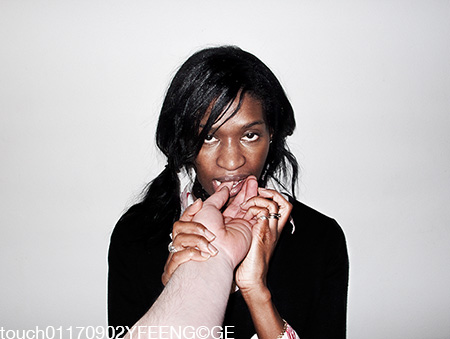
I was first introduced to Wole Soyinka’s work in 1992 when shooting a campaign for Talawa Theatre Company’s production of his play ‘The Road’. Shortly after, when making ‘dis’, I had the youthful temerity to ask Wole if he'd write me a poem. I had created a photograph that I believed only his insight and vision could seal the marriage between image and word. Despite his perilous circumstances he humbled my adolescent arrogance with a poem of terrifying beauty, profound resonance and perfect symbiosis. I never met or spoke with Wole, back then in 1993 the only way to communicate was by fax. At the time of correspondence he had sought sanctuary at the Sheraton Lagos, before fleeing Nigeria for the USA. More than a decade later I have this chance to safely repatriate Wole’s poem with a print of the finished artwork.

Skip to now. It's mid-March and the intransigent sky is still resolutely grey. Rehearsals are scheduled to start for Death and the King's Horseman when I get a call from Jenny(Jules). Over the years I have come to see Jenny as a wonderfully errant sister. She's an extraordinary talent, a gifted actor and stuff, but when we get together our senses of humour strain to be let off the leash and go bounding off in to the woods. She purrs she's got a lead part in a play at the NT. Enough, basta, comprendo, capiche! I get the message and catch the next train.

The role of King is filled by the imperious presence of Nonso Alozie. Standing in at a 6'6" he can quake the stage with the force of Ogun, or defy his mass and float with the light touch and agility of a bird.

Rufus's all black cast is a reassuringly welcome sight, peppered with familiar faces from past projects. Above them a newspaper advertisement hollered down. The Evening Standard is already stirring things in the direction of the box office with the headline 'Black Actors White Up at the National' -a provocatively cynical reference to Olivier's performance as Othello.
My fee is redeemed before the shutter is depressed. No price could be put on sitting in on rehearsals, watching an apprehensive cast find their way under Rufus and Javier's masterful stewardship. No money is exchanged, the equation is simple: I get access to remarkable subject matter plus a unique insight into inspirational artists at work -
I was royally paid.

The opportunity to shoot the cast in full costume came during dress rehearsals. The only available space was off-stage in rehearsal room 6; a windowless casket of coffee stained cream walls and plastic stacking chairs. It could be have been a waiting room or reception you'd find anywhere - Lagos or London. I resisted the temptation to neutralise it and opted to work with its... banality. The contrast of the actors, extraordinary in Katrina's exquisite finery, set against the ubiquitous sterility of their surroundings could be made to work to my advantage.

In Yoruban culture everything, including inanimate objects, has as spirit. The lampshade girl represents this 'Jinn' and she reappears throughout the sequence as a reminder of this belief. For the following six hours the session is a frenetic production line of masquerading black peacocks, priests, servants, musicians and African Royalty - real and fictional. Full dress rehearsals are a time of palpable panic, eyes in headlights stuff. I had between 90 seconds and 15 minutes to shoot each actor before they were spirited away, back on stage.

End of The Road. End of story.
